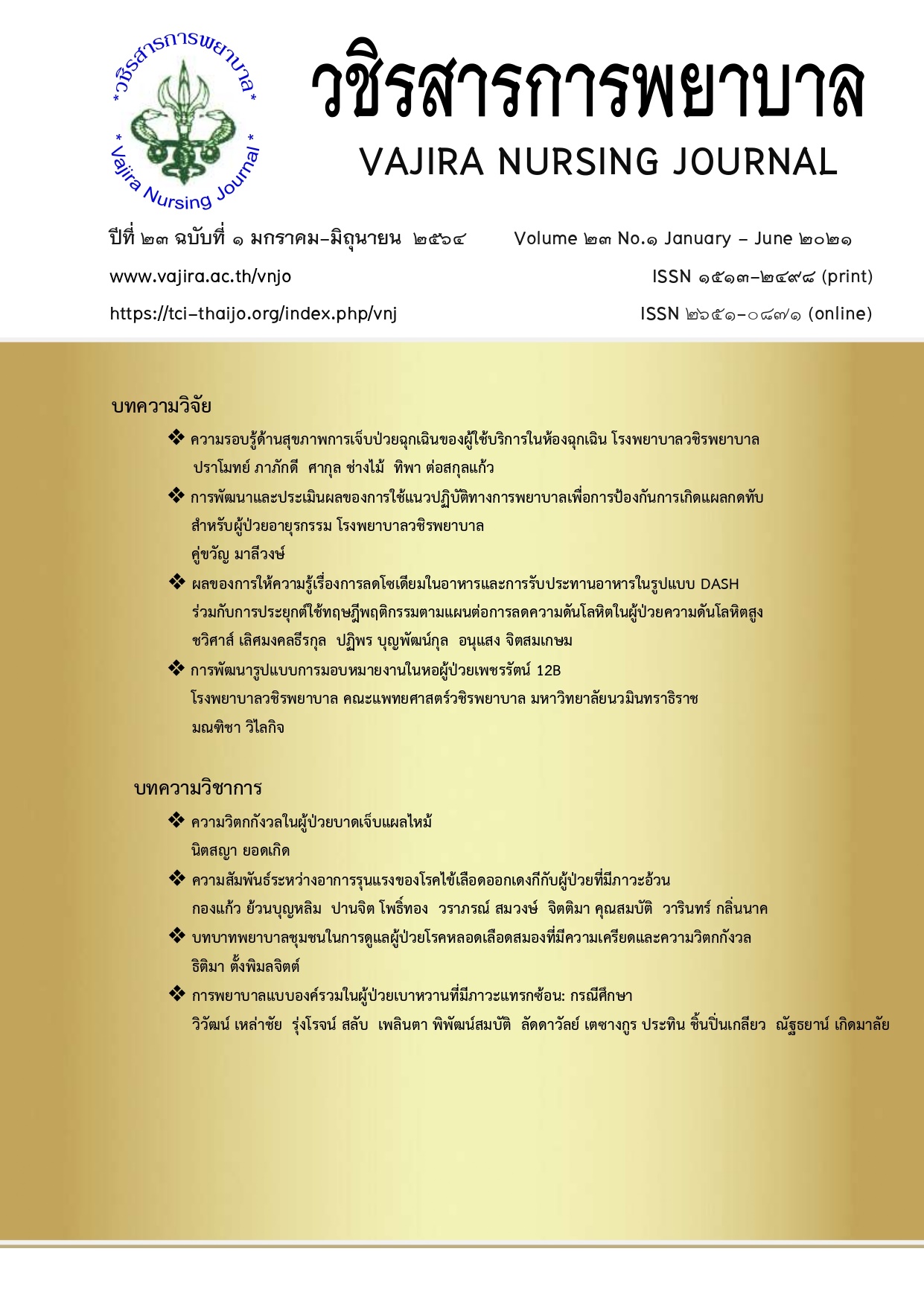การพัฒนาและประเมินผลของการใช้แนวปฏิบัติทางการพยาบาลเพื่อการป้องกันการเกิดแผลกดทับสำหรับผู้ป่วยอายุรกรรม โรงพยาบาลวชิรพยาบาล
Main Article Content
บทคัดย่อ
แผลกดทับเป็นปัญหาทางสุขภาพที่พบได้ร้อยละ10 ของผู้ป่วยที่นอนรักษาตัวในโรงพยาบาล เมื่อเกิดแผลกดทับจะส่งผลกระทบต่อตัวผู้ป่วยต้องทนทุกข์ทรมานกับบาดแผล และอาจเกิดการติดเชื้อจนเป็นอันตรายต่อชีวิตได้ และยังส่งผลต่อการดูแลรักษาที่เพิ่มขึ้น ความล้มเหลวในการป้องกันแผลกดทับนำไปสู่การฟ้องร้องทางกฎหมาย และอาจแสดงถึงคุณภาพการพยาบาลที่ยังไม่ได้มาตรฐาน การศึกษาครั้งนี้มีวัตถุประสงค์เพื่อพัฒนาและประเมินผลแนวปฏิบัติทางการพยาบาลในการป้องกันการเกิดแผลกดทับสำหรับผู้ป่วยอายุรกรรมที่เข้ารับการรักษาในโรงพยาบาลวชิรพยาบาล โดยดัดแปลงแนวคิดการพัฒนาแนวปฏิบัติทางคลินิกของสภาการวิจัยทางการแพทย์และสุขภาพประเทศออสเตรเลีย แบ่งเป็น 3 ระยะ คือ ระยะที่ 1 ระยะพัฒนาแนวปฏิบัติทางการพยาบาล ได้รวบรวมหลักฐานเชิงประจักษ์ที่ผ่านการประเมินระดับความน่าเชื่อถือและความเป็นไปได้ในการนำไปใช้ ระยะที่ 2 ระยะตรวจสอบคุณภาพ ร่างแนวปฏิบัติทางการพยาบาล และระยะที่ 3 นำแนวปฏิบัติทางการพยาบาลไปทดลองใช้กลุ่มตัวอย่าง จำนวน 34 ราย
ผลการวิจัย พบว่า แนวปฏิบัติทางการพยาบาลที่พัฒนาขึ้นประกอบด้วย 6 หมวด คือ 1) การประเมินความเสี่ยง 2) การป้องกันการเกิดแรงกด แรงเสียดสีและแรงเฉือน 3) การดูแลภาวะโภชนาการ 4) การดูแลสภาพผิวหนัง 5) การให้ความรู้แก่เจ้าหน้าที่และญาติผู้ดูแล และ6) การจัดการสิ่งแวดล้อม ผลการประเมินความสามารถของพยาบาลในการนำแนวปฏิบัติทางการพยาบาลไปใช้ มีคะแนนความพึงพอใจอยู่ในระดับดีมาก และการประเมินผลลัพธ์ทางคลินิก พบว่า ผู้ป่วยร้อยละ 100 ไม่เกิดแผลกดทับ จากผลการศึกษาครั้งนี้แสดงให้เห็นว่าแนวปฏิบัติทางการพยาบาลที่พัฒนาขึ้นมีความเหมาะสมในการนำไปใช้ป้องกันการเกิดแผลกดทับสำหรับผู้ป่วยอายุรกรรม ที่เข้ารับการรักษาในโรงพยาบาลวชิรพยาบาล และควรมีการพัฒนาอย่างต่อเนื่องเพื่อยกระดับคุณภาพการดูแลผู้ป่วยที่ยั่งยืน
Article Details

อนุญาตภายใต้เงื่อนไข Creative Commons Attribution-NonCommercial-NoDerivatives 4.0 International License.
เนื้อหาและข้อมูลในบทความที่ลงตีพิมพ์ในวชิรสารการพยาบาลถือเป็นข้อคิดเห็นและความรับผิดชอบของผู้เขียนบทความโดยตรง ซึ่งกองบรรณาธิการไม่จำเป็นต้องเห็นด้วย หรือร่วมรับผิดชอบใด ๆ ทั้งสิ้น
บทความ ข้อมูล เนื้อหา รูปภาพ ฯลฯ ที่ได้รับการตีพิมพ์ในวชิรสารการพยาบาล ถือเป็นลิขสิทธิ์ของวชิรสารการพยาบาล หากบุคคลใดหรือหน่วยงานใดต้องการนำทั้งหมดหรือส่วนหนึ่งส่วนใดไปเผยแพร่ต่อหรือเพื่อกระทำการใด ๆ จะต้องได้รับอนุญาตเป็นลายลักอักษรจากวชิรสารการพยาบาลก่อนเท่านั้น
เอกสารอ้างอิง
จิตร สิทธิอมร, อนุวัฒน์ ศุภชุติกุล, สงวนสิน รัตนเลิศ และเกียรติศักดิ์ ราชบริรักษ์. (2543). Clinical Practice Guideline; การจัดทำและนำไปใช้. กรุงเทพมหานคร : ดีไซน์.
จิณพิชญ์ชา มะมม. (2012). บทบาทพยาบาลกับแผลกดทับ : ความท้าทายในการป้องกันและการดูแล. วารสารวิทยาศาสตร์และเทคโนโลยี, 20(5), 478-490.
ฉวีวรรณ ธงชัย. (2548). การพัฒนาแนวปฏิบัติทางคลินิก. วารสารสภาการพยาบาล, 20(2), 63 – 76.
นภาพร ภมร. (2550). การพัฒนาแนวทางการพยาบาลเพื่อการป้องกันการเกิดแผลกดทับในผู้ป่วยสูงอายุโรงพยาบาลนภาลัย จังหวัดสมุทรสงคราม. (วิทยานิพนธ์ปริญญามหาบัณฑิต). มหาวิทยาลัยคริสเตียน, กรุงเทพ.
พุตตาน วงศ์ตรีรัตนชัย. (2556). Assessment of Pressure Ulcer and Benefit of Pressure Ulcer Treatment Following Clinical Practice Guideline.ใน: พรพรหม เมืองแมน Wound Care 2013.กรุงเทพเวชสาร 2556; 209-221.
พรพิลาศ พลประสิทธิ์. (2552). การพัฒนาแนวปฏิบัติการพยาบาลผู้ป่วยที่คาสายสวนหลอดเลือดดำ.กรุงเทพมหานคร.
ฟองคำ ติลกสกุลชัย. (2549). การปฏิบัติการพยาบาลตามหลักฐานเชิงประจักษ์: หลักการและวิธีปฏิบัติ.กรุงเทพมหานคร : ห้างหุ้นส่วนจำกัด พรี-วัน.
ยุวดี เกตสัมพันธ์, อัญชนา ท้วมเพิ่มผล, นภาพร อภิรดีวจีเศรษฐ์ และจุฬาพร ประสังสิต, (2552). การดูแลแผลกดทับ: ศาสตร์และศิลปะทางการพยาบาล. กรุงเทพมหานคร : ไทยเอฟเฟคท์สตูดิโอ
วิจิตร ศรีสุพรรณ, วิลาวัณย์ เสนารัตน์, วิลาวัณย์ พิเชียรเสถียร, ลัดดาวัลย์ สิงห์คำฟู และ นัททธานนท์. (2549). การดูแลผู้ป่วยที่มีแผลกดทับ (พิมพ์ครั้งที่ 3). เชียงใหม่ : นันทพันธ์พริ้นติ้ง.
สายฝน ไทยประดิษฐ์. (2556). ผลของโปรแกรมควบคุมความชื้นของผิวหนังต่อความสมบูรณ์แข็งแรงของผิวหนังและการเกิดแผลกดทับในผู้ป่วยสูงอายุที่มีความเสี่ยงต่อการเกิดแผลกดทับ. (วิทยานิพนธ์ปริญญามหาบัณฑิต). มหาวิทยาลัยสงขลานครินทร์, สงขลา.
สำนักพยาบาล สำนักปลัดกระทรวงสาธารณสุข กระทรวงสาธารณสุข. (2556). คู่มือการจัดเก็บข้อมูลสำคัญ. กระทรวงสาธารณสุข. กรุงเทพมหานคร.
สถิติกลุ่มการพยาบาล โรงพยาบาลวชิรพยาบาล. (2562). รายงานสถิติประจำปี 2562. กรุงเทพมหานคร.
อารยา โกมล. (2556). การพัฒนาและประเมินผลการใช้แนวปฏิบัติการพยาบาลเพื่อส่งเสริมการนอนหลับของผู้ป่วยในหอผู้ป่วยวิกฤต. (วิทยานิพนธ์ปริญญามหาบัณฑิต). มหาวิทยาลัยสงขลานครินทร์, สงขลา.
Bennett, E., Hauck, Y., Bindahneem, S., Banham, V., Owens, M., Priddis, L. et al. (2012). The development of an interdisciplinary research agenda at Ngala: an innovative case study.
Bergstrom, N., Braden, J.B., Laguzza, A. & Holman, V. (1987). The Braden scale for predicting pressure sore risk. Nursing Research, 36(4), 205-210.
Elliott, R., McKinly, S. & Fox, V. (2008) Quality improvement program to reduce the of pressure ulcers in an intensive care unit [Electronic version].
Elliott, R., McKinly, S. & Fox, V. (2008) Quality improvement program to reduce the prevalence of pressure ulcers in an intensive care unit [Electronic version]. American Journal of Critical Care, 17(4), 328-335.
Jaul, E. (2010). Assessment and management of pressure ulcers in the elderly: Current Strategies. Drugs & Aging, 27(4), 311-326.
The National Pressure Injury Advisory Panel. (2019). prevention and treatment of pressure ulcers/injuries: Clinical Practice Guideline. United States: University of Southern California (USC) Campus.
National Health and Medical Research Council [NHMRC]. (1998). A guide to the development, implementation and evaluation of clinical practice guidelines. Retrieved July 10, 2011, from http://www.ausinfo.gov.au/gen_hottobuy.html.
National Pressure Ulcer Advisory Panel. (2007). Pressure ulcer stages revised by NPUAP: Pressure Ulcer Definition. Retrieved September 13, 2012, from www.npuap.org/pr2htm.
National Pressure Ulcer Advisory Panel. (2009). European Pressure Ulcer Advisory Panel and National Pressure Ulcer Advisory Panel. Prevention and treatment of pressure ulcers: quick reference guide. Retrieved September 13, 2012, from www.npuap.org
The Appraisal of Guidelines for Research and Evaluation Collaboration. (2011). The of guidelines for research and evaluation [AGREE] instrument. Retrieved September 18, 2011, from http://www.agreecollabolation.org.


